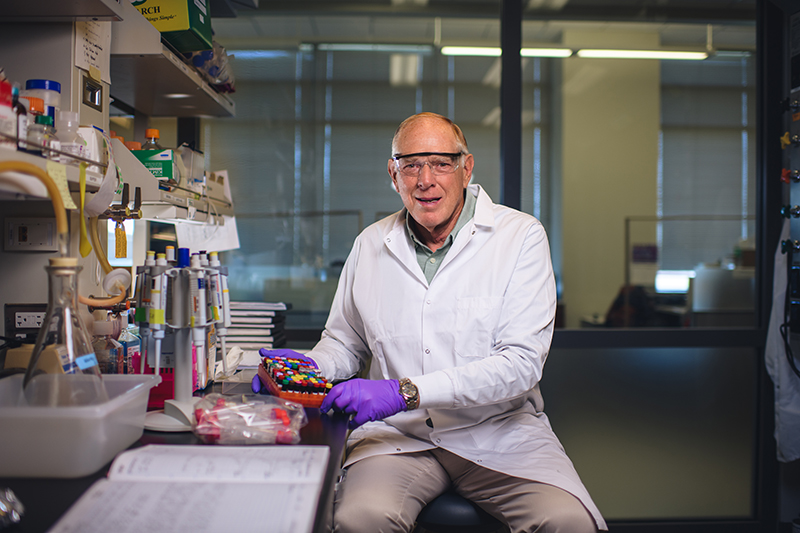Imaging agent illuminates lung cancer tumors
FDA approves new use of imaging agent to help light the way for surgeons during lung cancer surgery

An imaging agent just approved by the FDA will allow surgeons to identify additional cancerous lesions, which otherwise would have been left behind, in up to 24% more patients during non-small cell lung cancer surgery. Philip Low, Purdue University’s Presidential Scholar for Drug Discovery and Ralph C. Corley Distinguished Professor of Chemistry, is an inventor of the foundational intellectual property upon which the drug is based. (Purdue University photo/Rebecca McElhoe)
WEST LAFAYETTE, Ind. —
Surgery, especially surgery to remove cancerous tumors, relies on a range of tools and techniques as well as on the skill of the surgeon. Now, new imaging agent Cytalux will make surgery to remove lung cancer tumors a little more exact.
The inside of the human body famously looks nothing like an anatomy textbook, lacking the bright color coding to differentiate between tissues and organs. Based on foundational intellectual property developed at Purdue University and released by On Target Laboratories, Cytalux helps make tumors more easily and immediately identifiable by illuminating them and making them glow against healthy, noncancerous tissue like beacons against a night sky.
Philip Low (rhymes with “now”), Purdue’s Presidential Scholar for Drug Discovery and the Ralph C. Corley Distinguished Professor of Chemistry in the College of Science, is an inventor of the drug.
“Non-small cell lung cancer is one of the deadliest cancers,” Low said. “The only absolute cure for lung cancer is to surgically remove all of the malignant tissue out of the patient. If it has metastasized, it’s generally lethal.”
Lung cancer is the second most commonly diagnosed cancer in the world and accounts for more than a quarter of all cancer deaths in the U.S. every year. When a patient is diagnosed with non-small cell lung cancer, the prognosis is often bleak: Only 7% have a chance of living another five years.
The importance of removing all the malignant tissue, the difficulty in distinguishing cancerous tissue from healthy tissue and the widespread nature of this type of lung cancer make the use of Cytalux in lung cancer surgery a welcome development. Low, a chemist by trade, attacks these issues using his expertise in chemical reactions.
Cytalux exploits the unique chemistry of cancer cells to light up the tumors. Cancer cells divide rapidly, much faster than normal cells. To do this, they need folate, a type of B vitamin — and lots of it. The genius of Cytalux is that, after being administered intravenously to a patient before surgery, it tags that folate compound with a fluorescent dye. The cancer cells grab for the folate but end up flagged with the fluorescent dye, too. During surgery, these cells then fluoresce under near-infrared light. Low explains further how the drug works in this YouTube video.
The newly authorized use of Cytalux, which was initially developed to target ovarian cancer, has the potential to improve the outcomes of thousands of patients, helping surgeons to visualize otherwise undetected cancer tissue in 24% of lung cancer patients in a clinical trial.
“Cancer cells have an enormous appetite for this vitamin, and we have exploited their greed for folic acid by attaching a fluorescent dye to it,” Low said. “The drug not only allows the surgeon to see the cancer but may also help surgeons avoid removing tissue. Being able to avoid cutting healthy tissue can be as important as removing unhealthy tissues.”
Low and his team continue to develop imaging agents to make cancer tumors easier to detect and remove. He hopes that in the future all solid-tumor cancers will have a targeted fluorescent marker to light the way for surgeons.
“We’re leading the way in this effort,” Low said. “We are pioneers. We were not only the first tumor-targeted fluorescent dye to be approved by the FDA, but we developed a second one close on its heels. We are also working on other tumor-targeted fluorescent dyes to target many other types of cancer.”
Low conducts his research as part of the Purdue Center for Cancer Research. The center is one of only seven basic science laboratory cancer centers recognized by the National Cancer Institute, which is part of the National Institutes of Health. The center brings together more than 110 researchers at Purdue who study cancer at the cellular level.
Low and his team disclosed the innovation in imaging agents to the Purdue Research Foundation Office of Technology Commercialization. OTC applied for patent protection on the intellectual property and licensed it to On Target Laboratories, which is based in West Lafayette, Indiana. Low is the founder and chief science officer of On Target Laboratories.
About the College of Science
Purdue University’s College of Science is committed to the persistent pursuit of the mathematical and scientific knowledge that forms the very foundation of innovation. Nearly 350 tenure-track faculty conduct world-changing research and deliver a transformative education to more than 1,500 graduate students and 5,200 undergraduates. See how we develop practical solutions to today’s toughest challenges with degree programs in the life sciences, physical sciences, computational sciences, mathematics and data science at www.purdue.edu/science.
About Purdue University
Purdue University is a top public research institution developing practical solutions to today’s toughest challenges. Ranked in each of the last five years as one of the 10 Most Innovative universities in the United States by U.S. News & World Report, Purdue delivers world-changing research and out-of-this-world discovery. Committed to hands-on and online, real-world learning, Purdue offers a transformative education to all. Committed to affordability and accessibility, Purdue has frozen tuition and most fees at 2012-13 levels, enabling more students than ever to graduate debt-free. See how Purdue never stops in the persistent pursuit of the next giant leap at https://stories.purdue.edu
Writer/Media contact: Brittany Steff, bsteff@purdue.edu
Source: Phil Low, plow@purdue.edu
Note to journalists:
A video link is available to media who have an Associated Press subscription.



